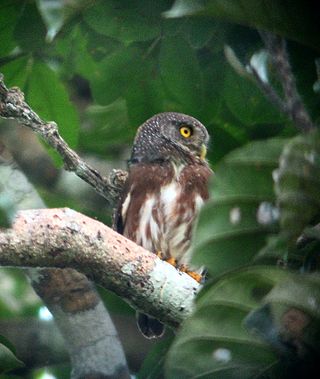
Cyanea hardyi, known in Hawaiian as hāhā, is a species of flowering plant in the bellflower family, Campanulaceae. This Hawaiian lobelioid is endemic to southern Kauaʻi. It inhabits forested valleys up to an elevation of 790 m (2,590 ft).

The Amazonian pygmy owl, also known as Hardy's pygmy owl, is an owl found in northern South America and the Amazon Basin. A member of the Strigidae family, it is a true owl.

Pritchardia hardy, the Makaleha pritchardia, is a species of palm tree that is endemic to moist forests on the island of Kauaʻi at elevations below 2,000 feet (610 m). The trunk of this fast-growing species reaches a height of 80 feet (24 m), with a diameter of 1 foot (0.30 m). Its leaves are 3 feet (0.91 m) in length. In 1998 only 30 individuals remained in the wild along a single trail on Kauai. This is a federally listed endangered species of the United States.

Siphonops is a genus of caecilians in the family Siphonopidae, found in South America. All species are known to occur within Brazil, however, only S. hardyi and S. leucoderus are endemic to it. The native ranges of the other two known species, S. annulatus and S. paulensis, extend outwards into the surrounding countries of Argentina, Bolivia, and Paraguay. S. annulatus's range extends even further, stretching into Colombia, Ecuador, French Guiana, Guyana, Peru, Suriname, and Venezuela, and giving it perhaps the most widespread distribution of any single caecilian species.
Siphonops hardyi, or Hardy's caecilian, is a species of caecilian in the family Siphonopidae. It is endemic to southeastern Brazil where it occurs in the states of São Paulo, Rio de Janeiro, Espírito Santo, and Minas Gerais, possibly wider. This species lives in soil and under leaf litter or stones in primary forest, plantations, and rural gardens. It is a common species; it can locally suffer from infrastructure development but is not generally threatened.

Aegialia is a genus of aphodiine dung beetles in the family Scarabaeidae.
Hardy's skink is a species of skink, a lizard in the family Scincidae. The species is endemic to the Poor Knights Islands of New Zealand.

The Tasmanian darner,, is a species of large dragonfly in the family Aeshnidae, which includes some of the world's largest dragonflies. It is found in Tasmania, Australia. The species was first described by Robert Tillyard in 1916 and inhabits streams and rivers.

The Siphonopidae are the family of common caecilians. They are found in Central and South America. Like other caecilians, they superficially resemble worms or snakes.

Austroaeschna hardyi is a species of large dragonfly in the family Aeshnidae, known as the lesser Tasmanian darner. It inhabits streams and rivers in Western Tasmania, Australia.

Hyperaspidius is a genus in the family Coccinellidae. There are at least 20 described species in Hyperaspidius.
Acanthodactylus hardyi, known commonly as Hardy's fringe-fingered lizard or the Nidua fringe-fingered lizard, is a species of lizard in the family Lacertidae. The species is endemic to Western Asia.
Brachycoryna is a genus of tortoise beetles and hispines in the family Chrysomelidae. There are seven described species in Brachycoryna.
Mallochohelea is a genus of biting midges in the family Ceratopogonidae. There are at least 40 described species in Mallochohelea.
Cadiz is a genus of leaf beetles in the subfamily Chrysomelinae, found in North America. It contains only one species, Cadiz hardyi, which was described from the Cadiz Dunes in San Bernardino County, California.
Brachycoryna hardyi is a species of leaf beetle in the family Chrysomelidae. It is found in Central America and North America.
Hyperaspidius hardyi is a species of lady beetle in the family Coccinellidae. It is found in North America.
Mecynothrips is a genus of thrips in the family Phlaeothripidae, first described by Richard Siddoway Bagnall in 1908. The type species is Mecynothrips wallaceiBagnall, 1908.
Opisthoteuthis hardyi is a lesser-known octopus species. It was described in 2002 from a male caught off the Shag Rocks, which are far south in the Atlantic Ocean near the Falkland Islands.

Ficimia hardyi, also known commonly as Hardy's hooknose snake, Hardy's hook-nosed snake, the Hidalgo hook-nosed snake, and nariz de gancho de Hardy in Mexican Spanish, is a species of nonvenomous snake in the family Colubridae. The species is endemic to Mexico.









